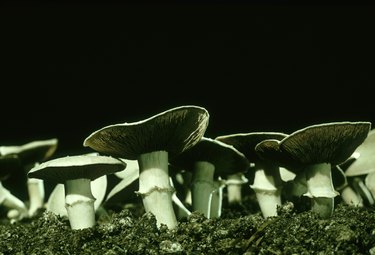
Growing your own mushrooms allows you to enjoy a range of edible mushrooms, including gourmet varieties you would otherwise avoid due to their cost. Building a fruiting chamber provides your mushrooms with a safe, clean place to spawn where they can avoid contamination that might ruin them. Not all mushrooms have the same growth requirements, so keep this in mind when building your chamber.
Choosing Mushrooms
Video of the Day
It's important to decide which type of mushrooms you want to grow before building a growing chamber because different strains have different growth requirements. Commonly grown strains include white button and portobello (Agaricus bisporus) mushrooms, which are both strains of the same species, and oyster mushroom varieties such as the golden oyster (Pleurotus cornucopiae) and white oyster (Pleurotus ostreatus). Shiitake (Lentinula edodes) mushrooms can also be grown at home, although they typically require more elaborate setups than the other varieties.
Video of the Day
Mushroom Innoculation
Before setting up a fruiting chamber, you should inoculate a substrate with mushroom spores to begin the mushroom life cycle. This can be done with purchased sterile spore syringes or by making your own inoculation solution with collected mushroom spores and distilled water. The sterile substrate can be bought in kits or made at home using steam-sterilized grains. Once inoculated, the mushroom fungus will grow and spread throughout the substrate to create what is known as a "spawn" to place in your fruiting chamber.
Lighting Concerns
The amount of light needed to grow mushrooms varies depending on the strain. Many strains do well with indirect sunlight or other soft light, though white button mushrooms and some others require complete darkness for fruiting. Direct sun is harmful to many mushrooms during the fruiting stage and should be avoided unless you're certain the strain you're growing needs it.
Ambient Temperature
Different mushroom strains require different temperatures for optimal growth. Some mushrooms do fine at regular room temperatures, while other strains, such as blue dolphin oysters (Pleurotus ostreatus), fruit best at temperatures below 65 degrees Fahrenheit. Other strains, such as shiitake and white oyster, are more versatile, fruiting anywhere between 55 and 75 F. For best results, read up on the strain's needs to find the ideal fruiting temperature for your mushrooms.
Air Flow and Humidity
Mushrooms need both good air flow and proper humidity for successful fruiting. Most mushroom varieties grow best with 80 to 95 percent humidity, including all of the common strains. This humidity can often be maintained by spraying a fine mist into the fruiting chamber once each day. Air flow is also important, as excess carbon dioxide can negatively affect mushroom fruiting. Incorporating sufficient ventilation or a small fan into your fruiting chamber ensures good air flow and prevents carbon dioxide buildup.
Fruiting Chamber Construction
Of the different types of mushroom fruiting chamber you can build at home, the simplest types are terrarium chambers. Terrarium chambers consist of a closed container with a layer of perlite or other moisture-retaining sterile material in the bottom and a rack to hold the substrate above that layer. Ventilation holes are then added near the top of the container to allow for air flow. Humidity tents are another option, and these are made of clear plastic that is supported by chopsticks inserted into the spawn's substrate material. Punch holes in the plastic to allow for air flow and gas exchange.